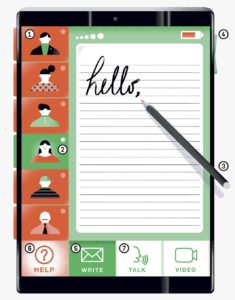 The computers, smartphones, and tablets that we use every day are becoming more advanced. Older adults who have cognitive or physical disabilities might have trouble using such devices. Technology should not just be for the young. We need to start thinking about how we can better adapt devices to fit the needs of our aging population.
The computers, smartphones, and tablets that we use every day are becoming more advanced. Older adults who have cognitive or physical disabilities might have trouble using such devices. Technology should not just be for the young. We need to start thinking about how we can better adapt devices to fit the needs of our aging population.
Recently, the Wired posted an article called Bigger, Brighter, Simpler: A Tablet For The Mature User that highlights some features of tablets which allows older adults to use them more successfully.
These features include:
- Clear Notifications
- A bright light illuminates the tab of the person just contacted, so users can keep track of in-progress conversations.
- Real Buttons
- Tablets should feature both physical buttons and the option to use a stylus and/or attachable keyboard.
- Super Size
- Tablet with a roomy 13-inch screen, preset to large text (experts suggest a 14-point font) with a bold, even typeface (like Arial, Futura, or Helvetica).
- Easy Charging
- A simple drop-in cradle doubles as a wireless charging station, with an indicator that clearly shows when a charge is in progress.
- Text-to-Speech, Speech-to-Text
- All text can be read aloud, and every video features captions.
Perhaps this is the start of designing tablet technology to help older adults navigate their Kindles and iPads with ease as they age. The cellphone industry, as you might already know, has been at this for awhile. There is a new Jitterbug smartphone on the market for older adults with similar features such as voice typing, a simple menu, and large icons and text.
Assessability is just one area that the Computing Community Consortium (CCC) has worked in over the past couple of years. In September 2014, the CCC hosted an Aging in Place workshop that led to the National Institute of Health‘s announcement of a new program called “Collaborative Aging (in Place) Research Using Technology (CART) (U2C).” A year later, the CCC held a workshop called Promoting Strategic Research on Inclusive Access to Rich Online Content and Services that brought together researchers and stakeholders from the disability community with researchers from relevant areas of computing research (such as computer vision, or natural language processing) to identify strategic opportunities to solve pervasive accessibility challenges through computing. Then in 2016, the CCC hosted a Discovery and Innovation in Smart and Pervasive Health Workshop to generate a white paper on the successes of Smart and Pervasive Health research activities, the evolution of relevant computing capabilities (sensing, advanced analytics, networks, data infrastructure), the application of these technical innovations across a range of wellness and healthcare needs (aging, disabilities, chronic disease management and prevention), and emerging paradigms (e.g., precision medicine and personalized treatment).









